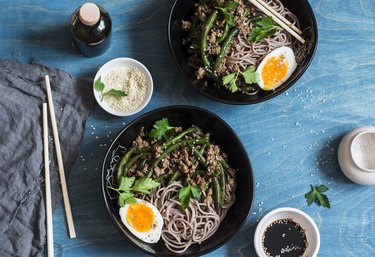
Giving up noodles or pasta during a weight loss plan is often tough for those who love carbohydrates. Fortunately, you can choose healthy options like soba noodles. Soba noodles calories are low and made up of healthy, complex carbs and protein.
Tip
Soba noodles, which are made from buckwheat flour, can be a good option for weight loss because they’re made up of whole grains, are low in fat and contain protein.
Video of the Day
Are Soba Noodles Healthy?
If you're a pasta and noodle lover, you're actually quite lucky: There's a great amount of variety in the types of noodles you can find. And if you're aiming for weight loss, you don't always have to cut out all carbs; you simply have to find the healthiest ones.
Video of the Day
There are a lot of different types of Asian noodles, including udon, ramen and soba. Asian noodles can be made from different grains and ingredients, some of which are healthier than others. You can find soba, udon, ramen, rice, glass or shirataki noodles in Asian stores or many grocery stores.
Soba is the Japanese term for buckwheat. Soba noodles are typically made from whole-grain buckwheat flour, according to Berkeley Wellness, and tend to have a nutty taste. Buckwheat noodles calories are whole grains, meaning they're complex carbohydrates that take longer to break down and provide energy to your body.
These noodles also sometimes contain wheat flour and salt in addition to buckwheat, meaning they're not always gluten free. Pure buckwheat noodles, however, are gluten free and are a decent option for people on gluten-free diets.
Soba noodles can be served hot or cold, and in addition to the complex carbohydrates from buckwheat, they can be a good source of protein, fiber, potassium and B vitamins. They also contain some minerals like calcium, iron, potassium, sodium and magnesium. One cup of soba noodles contains nearly 6 grams of protein, 40 milligrams of potassium and 10 milligrams of magnesium.
Read more: Best Grains on a Low-Carb Diet
Calculating Soba Noodles Calories
Fortunately, soba noodles are some of the healthiest options out there for carbohydrates. Unlike ramen noodles, which often contain oils, fat and salt, soba noodles calories (especially pure buckwheat) are very low in fat and cholesterol, provide healthy carbs and give you protein.
A September 2015 review published in the Journal of Agricultural and Food Chemistry found that buckwheat holds a lot of health benefits. Buckwheat may aid in lowering cholesterol, protecting the brain, fighting cancer and diabetes, working as an anti-inflammatory agent and improving blood pressure, the study notes.
Buckwheat may also help in protecting against cardiovascular disease. A May 2018 review and meta-analysis published in Nutrients found that people who ate buckwheat during an intervention experienced lower blood glucose, cholesterol and triglyceride levels.
All of these factors are a good sign for weight loss, but at the end of the day, how many pounds you shed also simply depends on how many calories you're consuming. To calculate buckwheat noodles calories, you can start out by knowing that one cup contains about 113 calories. Most of soba noodles calories come from carbs, and about 20 percent coming from protein.
Whole-grain carbs can be healthy and helpful for weight loss, especially if eaten in moderation. One small February 2017 study involving 81 men and women going through post-menopause, published in the American Journal of Clinical Nutrition, found that replacing refined grains with whole grains had a positive effect on energy balance and could potentially aid in weight loss.
Read more: List of Good Carbohydrates to Eat
Noodle Recipes for Weight Loss
Being creative with noodles can help make a weight loss plan easy and fun. First, purchase soba noodles that are 100 percent buckwheat. Buckwheat noodles calories are healthy and can be a good base for your meal.
To make soba noodle dishes ideal for losing weight, focus mostly on adding a good deal of vegetables to your dish. Veggies like broccoli, bok choy and spinach all contain a good deal of vitamins and minerals and are low in carbs and fat. Broccoli, for example, contains 80 milligrams of vitamin C and 92 micrograms of vitamin K, making up almost your full daily value for both of these vitamins.
Next, try adding a healthy protein to your noodle dish. Lean proteins like chicken are a great option for noodle dishes — and for losing weight. Tofu, which is common in noodle dishes, has a high level of protein, calcium, magnesium and zinc. You can also add a fried egg on top of your noodles for a good source of protein, vitamin A and vitamin B12.
Finally, make your noodles spicier or add some taste with sauces and spices. You can add chopped or minced garlic, red pepper flakes, ginger, green onions, salt, sesame oil or chili oil to your noodles to give them some more flavor.
- Berkeley Wellness: "6 Asian Noodles to Try"
- MyFoodData.com: "Nutrition Facts for Japanese Soba Noodles (Buckwheat)"
- Journal of Agricultural and Food Chemistry: "Buckwheat as a Functional Food and Its Effects on Health"
- Nutrients: "Buckwheat and CVD Risk Markers: A Systematic Review and Meta-Analysis"
- American Journal of Clinical Nutrition: "Substituting Whole Grains for Refined Grains in a 6-Wk Randomized Trial Favorably Affects Energy-Balance Metrics in Healthy Men and Postmenopausal Women"
- MyFoodData.com: "Nutrition Facts for Broccoli"
- U.S. National Library of Medicine: "Complex Carbohydrates"